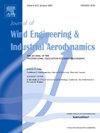Metal roof cladding system under wind loading: State-of-the-art
IF 4.2
2区 工程技术
Q1 ENGINEERING, CIVIL
Journal of Wind Engineering and Industrial Aerodynamics
Pub Date : 2025-02-01
DOI:10.1016/j.jweia.2024.105939
引用次数: 0
Abstract
Roof cladding, a vital component of any structure, is fabricated from material that is durable, affordable, and weatherproof. Metal roof claddings, known for their lightweight nature, durability, cost-effectiveness in construction and maintenance, and impressive strength-to-weight ratio, have been widely adopted worldwide. However, despite these advantages, metal roof claddings are particularly prone to failure during extreme wind events, such as storms, cyclones, and hurricanes. The two primary categories of metal roof claddings are long-run profiles and tray profiles. This study conducts a comprehensive review of research focused on standards used for quantifying wind loadings on roof structures, as well as the wind resistance capacity of various profiles of metal roof claddings under wind uplift loading. The review encompasses both experimental and numerical studies, exploring test methods, numerical modeling techniques, and modes of failures associated with different roof cladding profiles under wind uplift loading conditions. Additionally, the paper examines studies related to fragility and vulnerability analysis, along with risk assessment, pertaining to metal roof claddings. In conclusion, the paper offers critical remarks and provides recommendations for future work based on identified research gaps. The aim is to guide future studies in addressing challenges related to the wind performance of metal roof claddings and contribute to the development of more resilient and secure roofing systems.
风荷载下的金属屋面覆层系统:最先进的
屋顶覆层是任何结构的重要组成部分,由耐用、经济、防风雨的材料制成。金属屋顶覆层以其轻质、耐用、施工和维护的成本效益以及令人印象深刻的强度重量比而闻名,已在世界范围内广泛采用。然而,尽管有这些优点,金属屋顶覆层在极端风事件中,如风暴、旋风和飓风,特别容易失效。金属屋顶覆层的两个主要类别是长期运行型材和托盘型材。本研究对屋面结构风荷载量化标准的研究进行了全面综述,并对不同型态金属屋面覆层在风扬荷载作用下的抗风能力进行了研究。回顾包括实验和数值研究,探索测试方法,数值模拟技术,以及在风抬升荷载条件下与不同屋顶包层剖面相关的失效模式。此外,本文还审查了与金属屋顶覆层有关的脆弱性和脆弱性分析以及风险评估相关的研究。最后,本文提出了关键意见,并根据已确定的研究差距为未来的工作提供了建议。其目的是指导未来的研究,以解决与金属屋顶覆层的风力性能相关的挑战,并为开发更具弹性和安全性的屋顶系统做出贡献。
本文章由计算机程序翻译,如有差异,请以英文原文为准。
求助全文
约1分钟内获得全文
求助全文
来源期刊
CiteScore
8.90
自引率
22.90%
发文量
306
审稿时长
4.4 months
期刊介绍:
The objective of the journal is to provide a means for the publication and interchange of information, on an international basis, on all those aspects of wind engineering that are included in the activities of the International Association for Wind Engineering http://www.iawe.org/. These are: social and economic impact of wind effects; wind characteristics and structure, local wind environments, wind loads and structural response, diffusion, pollutant dispersion and matter transport, wind effects on building heat loss and ventilation, wind effects on transport systems, aerodynamic aspects of wind energy generation, and codification of wind effects.
Papers on these subjects describing full-scale measurements, wind-tunnel simulation studies, computational or theoretical methods are published, as well as papers dealing with the development of techniques and apparatus for wind engineering experiments.

 求助内容:
求助内容: 应助结果提醒方式:
应助结果提醒方式:


